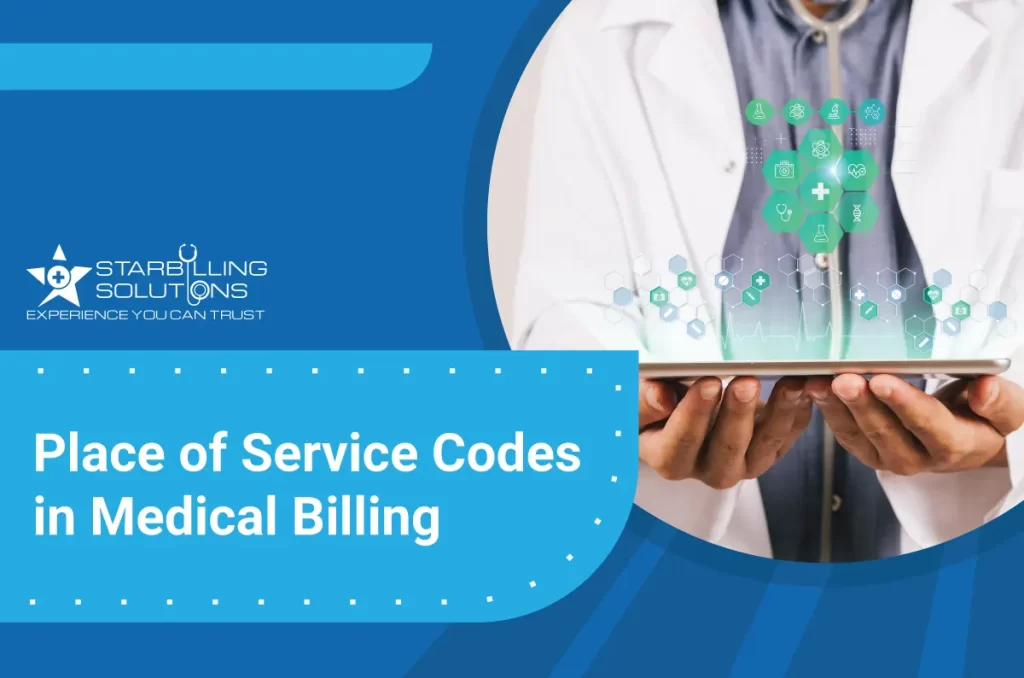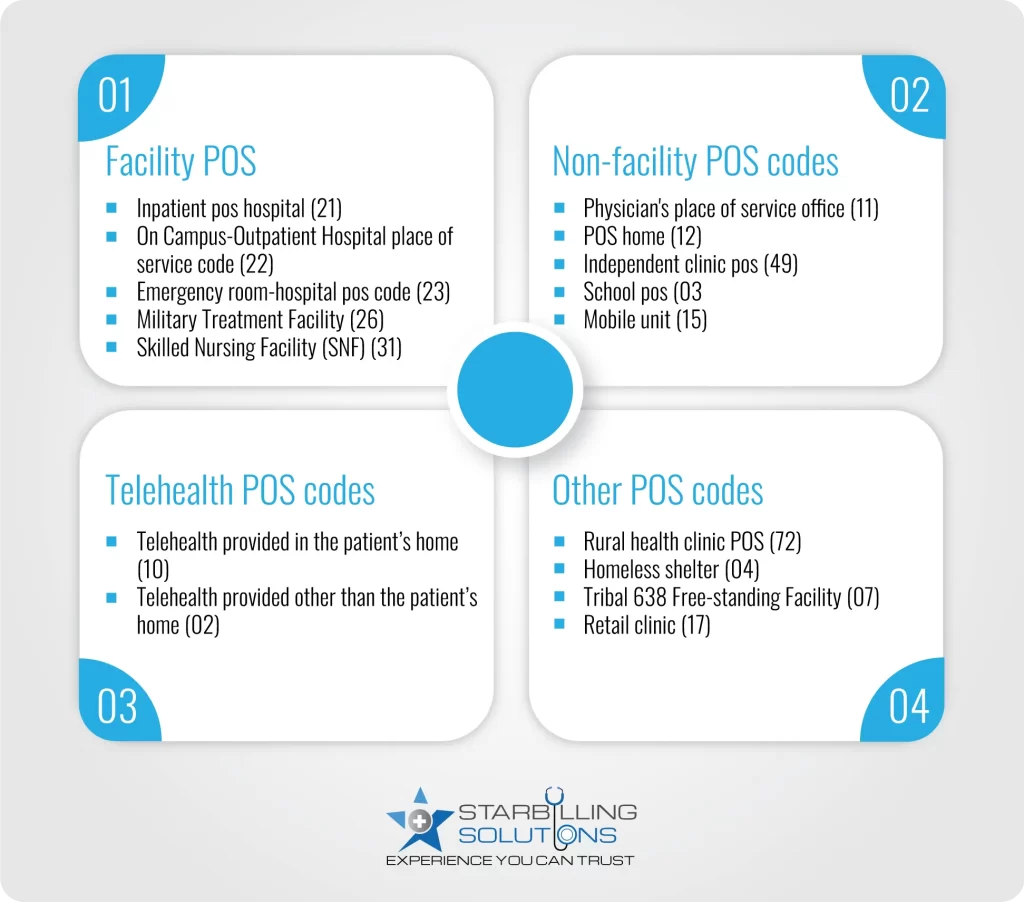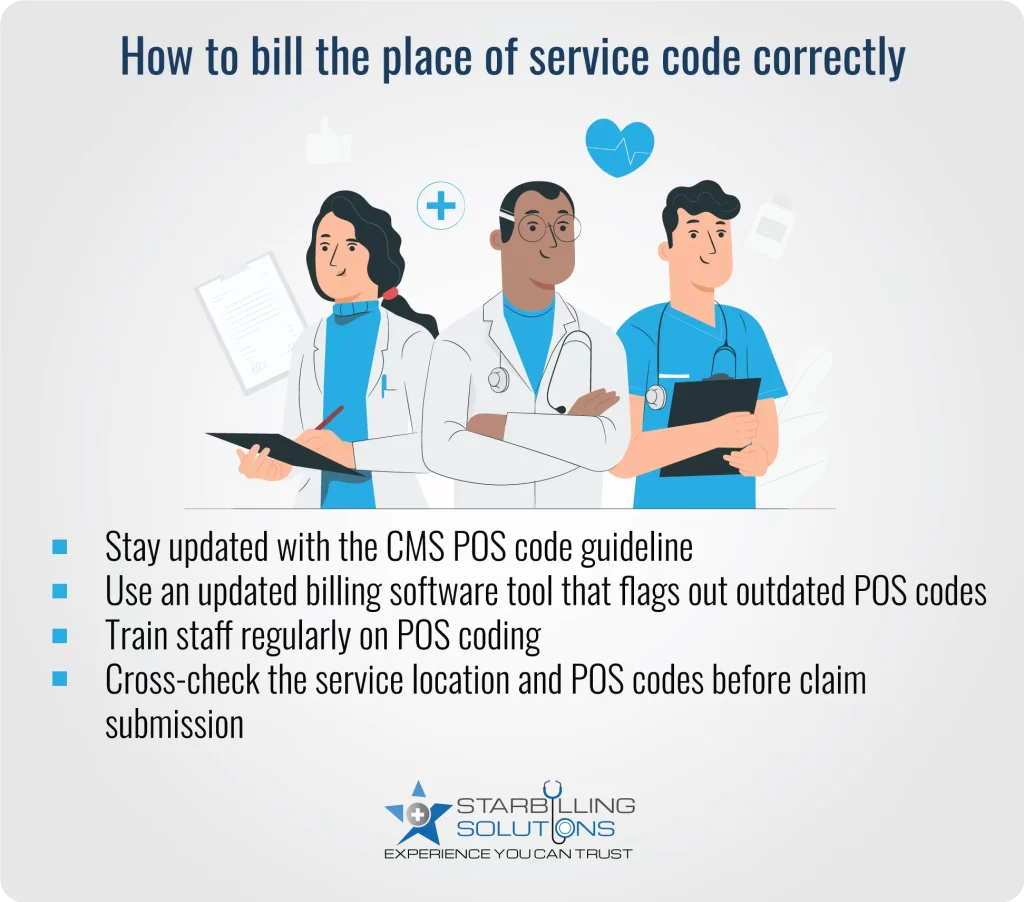
When drafting a healthcare claim, a crucial element that can’t be overcome is the Place of Service Codes in Medical Billing. A POS is generally a 2-digit code that indicates the location where the medical treatment was rendered.Whether a healthcare provider failed to use a POS code or placed it incorrectly in the claim, insurance providers will instantly deny it.
As a result, practices face delays in reimbursement, which also affect their revenue cycle management. That’s why understanding pos billing code is compulsory for every entity that directly or indirectly relates to healthcare.
Read this complete guide, which outlines the importance of POS, common mistakes, future trends, and the most widely used POS list.
Place of service codes, also known as POS codes or POS modifiers, are 2-digit codes that express the place where the provider delivers treatment to the patient. The Centers for Medicare and Medicaid (CMS) maintains place of service codes list, which are used throughout the healthcare industry.
This department is also responsible for maintaining and upgrading these standard codes on an annual basis. When drafting the CMS-1500, the 24B field is where the biller mentions POS codes. In short, pos list in medical billing identifies the place where patients receive care, whether it is in a hospital, clinic, practitioner’s office, or at the patient’s home.
pos for medical billing influences reimbursement, compliance, and healthcare RCM. Here’s why they are essential when submitting a claim.
Service charges for medical conditions vary from place to place. For instance, the services rendered in a hospital usually have higher reimbursement than those from office-based treatments. That’s when POS medical billing allows payers to identify the right amount to reimburse based on the treatment place.
Accurate insurance place of service codes ensure you comply with the coding guidelines set by Medicare, Medicaid, and private payers. If you misplace or wrongly enter the POS codes on a bill, the insurer will straightly deny your claim, which results in delayed reimbursement and revenue loss.
The average industry standard benchmark for Claim Denial Rate is typically around 5-10%, and among these, most denials are caused by a POS code error.Hence, to reduce this denial ratio,Medical place of service codes are crucial. Using the correct service code ensures claim integrity and approval because these codes specify where the service was rendered (e.g., hospital, office, home).
As discussed earlier, hospital treatment is reimbursed more than office treatment, which leads some providers to submit incorrect codes to get more healthcare reimbursement. Hence, incorporating pos billing codes prevents such fraudulent acts by providers and ensures that payers repay the provider with the right amount.
CMS implements some core updates regarding place of service medical billing codes and telehealth billing practices, which impact providers in the USA. Due to these changes, they get a lot of denials for claims. Here’s a quick overview of those changes.
POS 10 (Telehealth Provided in Patient’s Home): CMS has finalized POS 10 for telehealth service delivered in a patient’s home. Also, the claims billed under POS 10 are reimbursed at higher non-facility rates.
POS 02 (Telehealth Provided Outside the Home): The POS 02 code is used when telehealth services are rendered outside the patient’s home, such as a clinic or other healthcare facility.
Modifier 95:This modifier is still used for real-time synchronous audio-video telehealth services.
Modifier 93:For only audio-related telehealth services, the modifier 93 will be used. The CMS allows audio-only visits when behavioral health and chronic conditions are documented.
Providersshould stay up-to-date with these codes to ensure error-free claim submission, or they can consult with an expert medical coding service to secure claim approval at first hand.
The list of place of service codes in medical billing is categorized based on facility, non-facility, telehealth, and other settings. CMS standardizes these codes to specify the area where services are provided.

These settings involve institutions such as nursing homes, skilled nursing facilities, and hospital pos code where overhead and equipment are provided by the facility. Commonly used facility POS codes include:
These POS billing codes are used for locations where individual practitioners cover the overhead costs. Independent clinics and physician offices fall under the non-facility pos codes category.
Telehealth place of service billing codes are used when services are provided through telecommunication. It involves 2 standard codes, POS 02 and POS 10, where 02 is reimbursed at the facility rate while POS 10 is reimbursed at a non-facility rate.
Some place of services codes are made for specific scenarios which doesn’t fall under the main category. These unique or miscellaneous settings include retail clinics, homeless shelters, and rural health settings. Each of these categories serves a clear-cut purpose in healthcare.
Here’s the detailed POS code list and related description for professional claims. These codes are used in the United States for medical billing and insurance claims to specify the location where healthcare services are provided.
| POS Codes | Name | Description |
| Pos 01 | Pharmacy | A place where medication or drugs are provided to patients. |
| Pos 02 | Telehealth provider other than patient’s home | When healthcare services are provided to patients outside their homes. |
| Pos 03 | School | Educational institutes where healthcare services are provided. |
| Pos 04 | Homeless shelter | Temporary housing facilities provide services to homeless patients. |
| Pos 05 | Indian Health Service Free-Standing Facility | Standalone facility run by IHS for outpatient services to Native Americans. |
| Pos 06 | Indian health service provider-based facility | IHS facility in a hospital, which provides inpatient and outpatient services. |
| Pos 07 | Tribal 638 free-standing facility | Independent tribal facility that offers outpatient health services. |
| Pos 08 | Tribal 638 provider-based facility | Tribal facility in a hospital providing both inpatient and outpatient services. |
| Pos 09 | Prison/Correctional facility | Facilities where imprisoned persons receive treatment. |
| Pos 10 | Telehealth provided in patient’s home | Health services are provided remotely when the patient is at home. |
| Pos 11 | Office | Visit the physician’s office for a routine checkup and treatment. |
| Pos 12 | Home | Healthcare services are provided to patients at their residences. |
| Pos 13 | Assisted living facility | Residential facility offering personal and limited health services. |
| Pos 14 | Group home | A group home and private units offering 24/7 support and access to health and personal care services. |
| Pos 15 | Mobile unit | A mobile facility that travels to provide healthcare services. |
| Pos 16 | Temporary lodging | Short-term accommodation (hotel) where patients get treatment. |
| Pos 17 | Walk-in retail health Clinic | Clinic inside retail stores offering basic health services without appointments. |
| Pos 18 | Place of employment–worksite | The patient’s place of employment is where health services are provided. |
| Pos 19 | Off-Campus–outpatient hospital | The hospital department is located far from the main campus for outpatient services. |
| Pos 20 | Urgent care facility | Facility for immediate and emergency care without an appointment. |
| Pos 21 | Inpatient hospital | Hospitals where patients are admitted for overnight stays. |
| Pos 22 | On Campus–outpatient hospital | The hospital department on the main campus provides outpatient services. |
| Pos 23 | Emergency room–hospital | Hospital area for emergency medical care. |
| Pos 24 | Ambulatory surgical center | Facility for same-day surgical procedures without hospital admission. |
| Pos 25 | Birthing center | Facility for labor, delivery, and immediate postpartum care outside a hospital. |
| Pos 26 | Military treatment facility | Medical facility operated by the military for service members and their families. |
| Pos 27 | Outreach site/ street | Non-permanent locations where healthcare services are provided to unsheltered patients. |
| Pos 28-30 | Not assigned | N/A |
| Pos 31 | Skilled nursing facility | Facility providing inpatient nursing and rehabilitation services. |
| Pos 32 | Nursing facility | Facility offering nursing services and other related services to residents. |
| Pos 33 | Custodial care facility | A long-term care facility that provides personal assistance without medical services. |
| Pos 34 | Hospice | A facility that offers end-of-life care for terminally ill patients |
| Pos 35-40 | Not assigned | N/A |
| Pos 41 | Ambulance – land | Ground vehicle equipped for emergency patient transport |
| Pos 42 | Ambulance–air or water | Aircraft or boats equipped for emergency patient transport |
| Pos 43-48 | Not assigned | N/A |
| Pos 49 | Independent clinic | A clinic that is not part of a hospital but provides outpatient services. |
| Pos 50 | Federally qualified health center | Community-based clinic offering healthcare services in underserved areas. |
| Pos 51 | Inpatient psychiatric facility | A facility that offers 24-hour inpatient mental health care. |
| Pos 52 | Psychiatric facility–partial hospitalization | Facility offering structured mental health programs without overnight stays |
| Pos 53 | Community mental health center | Centers providing comprehensive mental health care to the community. |
| Pos 54 | Intermediate care facility/mentally retarded | Facilities offering care to individuals with intellectual disabilities. |
| Pos 55 | Residential substance abuse treatment facility | Live-in facility for individuals undergoing substance abuse treatment. |
| Pos 56 | Psychiatric residential treatment center | A 24-hour staffed facility that provides group living and treatment for people with mental health needs. |
| Pos 57 | Non-residential substance abuse treatment facility | A place that offers walk-in treatment for drug and alcohol abuse. |
| Pos 58 | Non-residential mental health facility | A place that offers walk-in treatment for opioid addiction. |
| Pos 59 | Not assigned | N/A |
| Pos 60 | Mass immunization center | Location where large-scale vaccinations are administered. |
| Pos 61 | Comprehensive inpatient rehabilitation facility | A hospital-like facility where inpatients stay to receive rehabilitation services, such as physical and occupational therapy. |
| Pos 62 | Comprehensive outpatient rehabilitation facility | A place where outpatients with physical disabilities stay to receive complete rehab services like physical and occupational therapy. |
| Pos 63-64 | Not assigned | N/A |
| Pos 65 | End-stage renal disease treatment facility | A facility (not a hospital) providing dialysis treatments for kidney failure patients. |
| Pos 66 | Programs of all-inclusive care for the elderly (PACE) centers | A center offering comprehensive medical and social services to elderly individuals enrolled in PACE. |
| Pos 67-70 | Not assigned | N/A |
| Pos 71 | Public health clinic | A clinic run by state or local health departments provides primary medical care. |
| Pos 72 | Rural health clinic | A certified clinic in rural areas offering primary medical care. |
| Pos 73-80 | Not assigned | N/A |
| Pos 81 | Independent laboratory | A lab that performs diagnostic tests independently, not part of a hospital or physician’s office. |
| Pos 82-98 | Not assigned | N/A |
| Pos 99 | Other place of service | Any other location where services are provided that doesn’t fit into the above categories. |
Accurate place of service codes are essential for getting quicker claim approval, faster reimbursement, and maintaining a healthy revenue cycle management. However, even a small error in POS codes could lead to denials. Let’s take a look at some of the common mistakes in place of service billing codes to watch for:

In order to perform medical place of service codes correctly, it is first important to stay up-to-date with CMS’s POS code guidelines and payer-specific regulations.
Additionally, use the updated billing software that automatically flags out outdated or mismatched POS codes.
You also need to train your staff regularly on coding, especially for telehealth, hospital, and office-based services. Lastly, cross-check the service location and POS codes before submission to ensure accuracy in codes.
Regulations on the POS list often change with CMS, which makes the service code in medical billing complex, time-consuming, and prone to errors. That’s why it’s necessary to hire an expert billing company that specializes in accurate and compliant medical billing to ensure all services are coded correctly based on their location. Whether it’s telehealth, in-office, or urgent care, our team stays up to date with the latest CMS pos billing regulations. So you don’t have to worry about rejections, audits, or compliance risks. Contact us today or schedule a word-free code audit and let us take care of the coding while you focus on patient care.
Medicare, Medicaid, and private payers use POS codes to determine location-specific reimbursement rates and authenticate medical necessity.
A claim POS line accommodates only 1 POS code at a time, which means you can’t place 2 Codes.
Place the 2-digit POS code on the CMS-1500 claim form in section 24-b, which is specifically designed for the place of service.
POS 11 and POS 22 are two different place-of-service codes in medical billing. Both of them depict the place where treatment was rendered. POS 11 reflects the physician's office, while POS 22 shows an on-campus outpatient hospital setting. Furthermore, POS 11 generally results in higher reimbursements because providers are responsible for covering their own overhead.